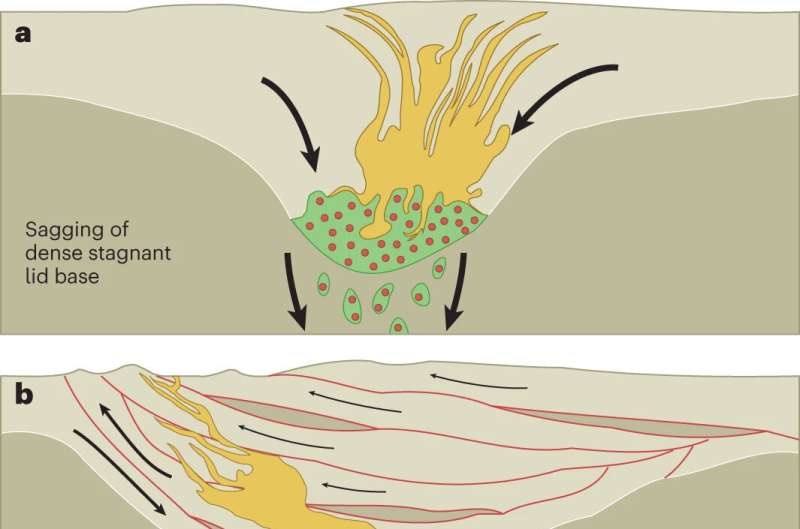September 18, 2023 feature
This article has been reviewed according to Science X's editorial process and policies. Editors have highlighted the following attributes while ensuring the content's credibility:
fact-checked
peer-reviewed publication
trusted source
proofread
Plate tectonics 4 billion years ago may have helped initiate life on Earth

The Earth's oldest surface layer forming continents, termed its crust, is approximately 4 billion years old and is comprised of 25–50km-thick volcanic rocks known as basalts. Originally, scientists thought that one complete lithospheric crust covered the entire planet, compared to the individual plates we see today which were believed to have only begun formation 1 billion years later. However, attitudes towards this hypothesis are being challenged.
The formation mechanism of this continental crust is somewhat enigmatic, with academics now suggesting it may have been driven by plate tectonics, the movement of Earth's major surface plates across the globe over billions of years, forming the landmasses and topographic features which we see today.
One theory focuses on when the plates converge, often causing one to subduct beneath the other, resulting in partial melting to change magma composition, while another studies mechanisms occurring within the crust itself (at less than 50km depth) that are entirely separate from plate boundaries but also cause partial melting.
New research published in Nature Geoscience reports experimental work on an analog for oceanic plateaus, large flat elevations with steep edges, that are representative of this early basaltic crust which initially formed in the Eoarchean (3.6–4 billion years ago).
Dr. Alan Hastie, based at the University of Edinburgh, and colleagues subjected primitive oceanic plateau basalts from the southwestern Pacific Ontong Java Plateau to high-pressure-temperature melting experiments.
This revealed continental crust could not form at pressures <1.4 GigaPascals (GPa) occurring up to 50km depth, therefore indicating such magmas formed during convergent subduction zones. Consequently, they suggest plate tectonics, even if only a primitive form, existed 4 billion years ago.
This knowledge is powerful as plate tectonics are responsible for erosion, deposition, mountain formation and volcanic activity, which play various roles in the formation of continental crust. The research team suggest that gases released from volcanism, especially carbon monoxide and methane, may have helped the initiation of life on Earth by being a source of prebiotic molecules leading to the first microbial organisms.
Beyond Earth, the silica-rich continental crust here has also been found in smaller volumes on Mars and Venus, offering insight into the role of plate tectonic in the wider solar system.
Dr. Hastie and colleagues investigated the stability of a number of minerals at varying pressures (1.2–1.4GPa, equivalent to ~40–50km depth) to determine at which point they transformed, with potential mantle temperatures reaching 1,500–1,650°C. Key minerals for the study were garnet (which is known to be stable at pressures >1GPa, equating to ~30km depth) and plagioclase feldspar (stable up to ~1.8GPa, ~60km depth), rutile (stable at 0.7-1.6GPa, ~25–55km depth) and amphibole (controls dehydration melting reactions).
The experimental results found that garnet and rutile were not stabilized at <1.4GPa (~45–50km depth), which was higher than previous studies had found, but the team attribute to their starting oceanic crust having a higher magnesium content more in line with the expected composition of Eoarchean mafic (iron and magnesium-rich) crust.
They also ran a reverse experiment in which they grew garnet crystals at higher pressure (2GPa) before subjecting it to the lower pressure of 1.4GPa and found that the garnet crystals began to break down. Subsequently, they found that a pressure of ~1.6GPa (>50–55km depth) was stable for garnet, increasing the previously held belief of stability at 1GPa, and therefore increasing depth of formation. Consequently, subduction is the more suitable mechanism to explain this response.
Modeling also suggests that early magmas were subjected to fractional crystallization as they rose through the crust, whereby crystals separated from the liquid magma, leaving the remaining magma pool depleted in certain elements used in the initial crystals so the composition continually changes as more crystals form.
Through this, the research team identified amphibole crystallization as a major driver in partial melting, due to it being a hydrous mineral that may have been incorporated into the crust by overturning and burial. This matches signatures of known Eoarchean volcanic rocks, such as tonalites and trondhjemites.
The Isua Greenstone Belt, Greenland, and Archaean Slave Craton, Canada, are thought to be two remnants of convergent plate margins above ancient subduction zones. In such areas, metabasic (metamorphosed basaltic and allied rocks) magmas would have mixed with fluids from the melting subducting crust to produce new silica-rich magmas, the beginnings of a cycle of continental destruction and rebirth that has shaped the world we see today.
More information: Alan R. Hastie et al, Deep formation of Earth's earliest continental crust consistent with subduction, Nature Geoscience (2023). DOI: 10.1038/s41561-023-01249-5
Allen P. Nutman, Forming the oldest-surviving crust, Nature Geoscience (2023). DOI: 10.1038/s41561-023-01252-w
Journal information: Nature Geoscience
© 2023 Science X Network




















